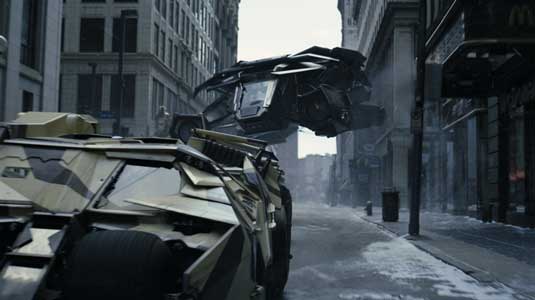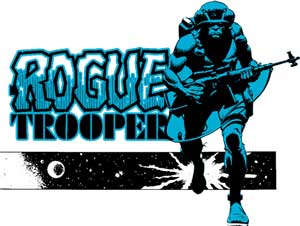
This article is brought to you in association with Masters of CG, a new competition that offers the chance to work with one of 2000AD's most iconic characters. There are big prizes to be won, so enter today!
Starting as a runner at Double Negative in its founding year, and working there ever since, Pete Bebb has had a spectacular career in visual effects. From his early work on Pitch Black through to his Oscar for Inception, he's worked on some of the century's biggest blockbusters. And when it comes to recent movie trends, he doesn't pull his punches.
Take stereoscopic 3D. "Stereoscopic purely came about because it brought another 20 per cent in the box office," is his blunt assessment. "But studios were unwilling to film in stereo because it cost a lot more. Post-process is a lot cheaper for them."
That in itself is not an issue, he says, as long as it's built into the production pipeline. But when the decision to convert 2D into 3D is bolted on as a rushed afterthought - often because the movie's investors change their mind at the last minute - the quality of the resulting viewing experience can suffer.
In the pipeline
"I won't name names but we're all aware of them; certain films where stereofication has actually been a bad idea," he says. "The visual effects artists have spent a long time getting it right in 2D. But then the client decides to make it all stereo, at the very last minute. And there isn't always time to do a really good job."
As a result, Bebb says, Double Negative now tends to incorporate stereoscopic 3D into the VFX pipeline as a matter of course - even if the client doesn't ask for it.
"We ask at the very start: 'Is this going to be a stereo show?'," he explains. "But even if the answer's no, we usually prep for it anyway. We build it into the pipeline, and so if they decide later on that they want us to split out right eye, left eye, then that's fine."
Daily design news, reviews, how-tos and more, as picked by the editors.
Working with Nolan

Personally, Bebb isn't a big fan of stereo 3D anyway. "I don't think it usually brings a huge amount to the viewing experience," he believes. "Myself, I'd rather watch in mono." Luckily, he has a like mind in one of his closest collaborators, Dark Knight director Christopher Nolan. "Chris hates stereo," says Bebb. "He will not go there. He thinks it's a big hoax."
And there's an even more fundamental meeting of minds on the subject of visual effects. Both men are keen that as much of the action is captured in the camera from the first, rather than created by an army of VFX artists in post.
"This isn't the sort of thing a person working VFX should probably say," adds Bebb. "But I do worry somewhat about the general adage: 'Let's just do it all in visual effects - because we can.' I still think that if you can get everything in camera then brilliant. Because really, you're never going to beat a one-to-one model of a Batmobile."
Getting it in-camera
And perhaps not surprisingly, it's Nolan's films Bebb considers Double Negative has done its best work on. "As far as specific scenes that stick out, there's one in Dark Knight Rises of The Bat coming down and strafing the Oshkosh in the street - that was a nice one," he recalls. "There's also the Batpod emerging from the Batmobile in the Dark Knight.
"That was a cracking sequence - purely because they tried to shoot it. Nolan was trying to get as much as he could in camera, which is the perfect way to approach visual effects. As I say, they shouldn't be the first port of call."
But when you simply can't film something, then Bebb's your man - and that was certainly the case with Inception, a brain-twisting sci-fi epic involving multiple-level dream worlds where nothing makes sense and the laws of gravity cease to apply. As Bebb puts it: "You can't fold Paris. You can't put buildings in water just floating around."
Photorealism
As co-VFX Supervisor on the movie, he was recognized with an Academy Award, a BAFTA award and a VES award. But the biggest prize, to Bebb's mind, is when even the best eyes in the business don’t spot the visual effects. When his team had finished a scene involving buildings floating surreally in water, Nolan himself was initially unaware that they’d replaced the water filmed in camera.
"Actually we had to replace it, we'd never have been able to get the reflection and the refraction right otherwise," smiles Bebb. "But the fact that we created something so photorealistic that it convinced Chris means we're obviously doing something correct, because his eye is so good. And that's the most important thing to me; creating something that photoreal that convinces someone of his calibre."
Joint effort

But before you start thinking that Bebb is some kind of magician, he's keen to point to the 300-odd army of artists who work hard over long hours to achieve his vision. He refers to his role as a supervisor self-deprecatingly as "a bit like a diva", and says that nothing would be possible without the brilliant artists working on such scenes. And nor did Bebb get to where is today overnight; it's been a long, tough climb that began right on the bottom rung.
"After doing my Masters, I just came down to London not knowing a huge amount about the industry at all," he explains. "I just knew that I loved watching films." He got a job as a runner at Double Negative, where he helped set up the Shaftesbury avenue office they'd just moved into.
"Because it was a new company and things were very fluid, I spent time working in all the various departments," he recalls. "Which was great for me because I didn't really know much about it anyway."
Self-taught
Alongside his day job, Bebb spent every spare minute he had becoming self-taught in 3D software. "Back then it was Power Animator that I was learning," he explains. "Maya had just come out so I was soon learning that. I'd be coming in about 8am, I'd be learning a little about that, then I'd do my job, then I'd be there 11pm, 12midnight learning the software.
"You do this for love so you don't really count the hours when you're a kid. You've got nothing else to do, anyway - you've got no money!"
Bebb's first roles as 3D artist, concept/previs and team lead were on the likes of Die Another Day, Alien vs Predator and Harry Potter and The Goblet of Fire. Then just two years into his career, he began working as sequence supervisor and CG supervisor on films such as Batman Begins, The Dark Knight, World Trade Center and Captain America. And his CV continues to load up with big-name films - the latest release he's allowed to talk about being 2013's Thor: The Dark World.
Start at the bottom
The work-your-way-up approach has clearly out worked for Bebb, and it's one he'd strongly recommend to others. "I'm not a massive supporter of students coming in with fancy qualifications and just thinking that they're going to walk into a live project and earn copious amounts of money," he says. "As with everywhere in the film industry, camera department and all the rest of it, there's a very strict hierarchy and a process which you have to adhere to get to the top."
But even though it's hard graft and you have to pay your dues, Bebb does urge as many people as possible to consider a career in the business. "There's more demand than ever for young 3D talent," he enthuses. "Double Negative has gone from 30 to over 1000 in two countries, and that sort of growth has applied across the board to a lot of other facilities. So it's definitely a growing industry - and we need to get a lot more people entering it if we can."
Win a trip to SIGGRAPH!

Masters of CG is an exciting new competition for EU residents that offers you the one-in-a-lifetime chance to work with one of 2000AD's most iconic characters: Rogue Trooper.
We invite you to form a team (of up to four participants) and tackle as many of our four categories as you wish - Title Sequence, Main Shots, Film Poster or Idents. For full details of how to enter and to get your Competition Information Pack, head to the Masters of CG website now.
Enter the competition today!

Tom May is an award-winning journalist specialising in art, design, photography and technology. His latest book, The 50 Greatest Designers (Arcturus Publishing), was published this June. He's also author of Great TED Talks: Creativity (Pavilion Books). Tom was previously editor of Professional Photography magazine, associate editor at Creative Bloq, and deputy editor at net magazine.
